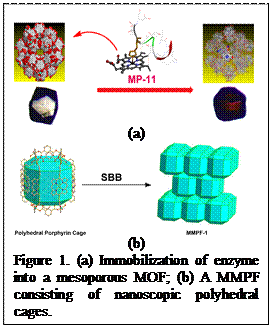Syntheses and Characterizations of Catalytically Active Porous Metal-Organic Frameworks (MOFs)
Shengqian Ma, Assistant Professor
Department of Chemistry
University of South Florida, Tampa, Florida 33620
sqma@usf.edu; 813-974-5217
 Overview of Shengqian Ma’s group: The Ma group works primarily on developing porous MOF materials for catalysis applications. Current emphasis is on the development of mesoporous MOFs as platforms to immobilize enzymes/proteins for biocatalysis application (Figure 1a) and rational design of porous metal-metalloporphyrin frameworks (MMPFs) as heterogeneous catalysts to mimic zeolites for size/shape selective catalysis (Figure 1b). This objective of this RET project is to synthesize a series of new mesoprous MOF and MMPF structures, which will be employed for catalysis performance evaluation.
Overview of Shengqian Ma’s group: The Ma group works primarily on developing porous MOF materials for catalysis applications. Current emphasis is on the development of mesoporous MOFs as platforms to immobilize enzymes/proteins for biocatalysis application (Figure 1a) and rational design of porous metal-metalloporphyrin frameworks (MMPFs) as heterogeneous catalysts to mimic zeolites for size/shape selective catalysis (Figure 1b). This objective of this RET project is to synthesize a series of new mesoprous MOF and MMPF structures, which will be employed for catalysis performance evaluation.
Teacher Project: The goal of this project for the teacher is to synthesize catalytically active porous MOF materials and evaluation of their performances in chemical fixation of CO2. The teacher will learn how to synthesize MOFs using hydro/solvothermal methods. Upon their successful growth of MOF crystals, the teacher will be taught how to utilize single crystal x-ray diffraction and powder x-ray diffraction to characterize the structures of prepared MOFs crystals. In addition, the teacher will be trained to use gas sorption apparatus to meassure the porosities and surface areas of MOF materials as well as thermal gravimetric instrument to assess the thermal stability of MOF materials. After the characterizations of the prepared porous MOF materials, the teacher will work with a graduate student to build a catalytic reaction setup, and to run some catalytic reactions of chemical fixation of CO2 to systematically evaluate the performances of the MOF catalysts.
All facilities will be in-place for the teacher to start the project immediately. The first few days will be spent on reading a few relevant journal articles (which will be provided ahead of time), training on the synthesis method, learning the use of TGA, gas sorption, IR instruments, and discussions with Ma and the involved graduate student (Wenyang). There will be one REU student working alongside the teacher on related project. Depending upon progress, co-authorship of a journal article is possible for the teacher, from this project.- 1. Upconversion Photocatalysis for Energy and Environmental Applications
- 2. Sorption of Organic Vapors by Polymers using a Quartz Crystal Microbalance
- 3. Effective Deposition and Spreading of Powder Layers for 3D Printing
- 4. Synthesis and Characterization of Structured Nanomaterials for Energy Applications
- 5. Syntheses and Characterizations of Catalytically Active Porous Metal-Organic Frameworks (MOFs)
- 6. Microfluidic Filtration of Circulating Tumor Cells
- 7. Simulation and Rational Design of Metal-Organic Materials
- 8. Composition of Organic and Inorganic Polymeric Nanofibers for Filtering, Tissue Scaffolding, Wavelength Reflecting, and Self-healing Functionalities
- 9. Dynamic Tissue Cultures for Cell Printing
- 10. Synthesis and Characterization of Nanocomposites for 3D Printed RF Devices